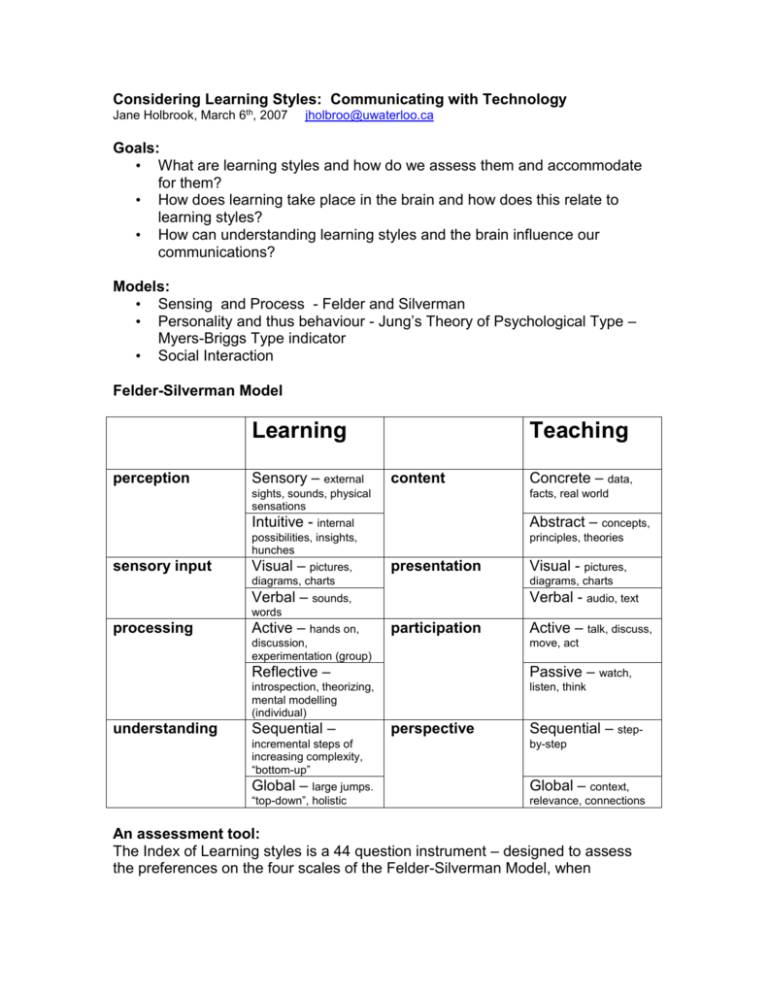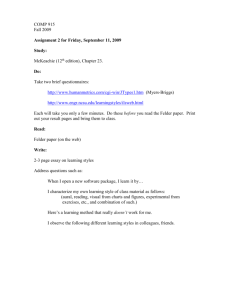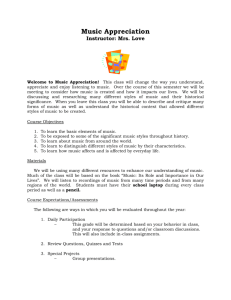Meeting handout
advertisement

Considering Learning Styles: Communicating with Technology Jane Holbrook, March 6th, 2007 jholbroo@uwaterloo.ca Goals: • What are learning styles and how do we assess them and accommodate for them? • How does learning take place in the brain and how does this relate to learning styles? • How can understanding learning styles and the brain influence our communications? Models: • Sensing and Process - Felder and Silverman • Personality and thus behaviour - Jung’s Theory of Psychological Type – Myers-Briggs Type indicator • Social Interaction Felder-Silverman Model Learning perception sensory input Sensory – external Teaching content Concrete – data, sights, sounds, physical sensations facts, real world Intuitive - internal Abstract – concepts, possibilities, insights, hunches Visual – pictures, diagrams, charts principles, theories presentation Visual - pictures, diagrams, charts Verbal – sounds, Verbal - audio, text words processing understanding Active – hands on, participation Active – talk, discuss, discussion, experimentation (group) move, act Reflective – Passive – watch, introspection, theorizing, mental modelling (individual) listen, think Sequential – incremental steps of increasing complexity, “bottom-up” Global – large jumps. “top-down”, holistic perspective Sequential – stepby-step Global – context, relevance, connections An assessment tool: The Index of Learning styles is a 44 question instrument – designed to assess the preferences on the four scales of the Felder-Silverman Model, when submitted on line is scored and returned to the submitter with the scale scores on the four dimensions and a brief explanation of how the scores can be interpreted. http://www.engr.ncsu.edu/learningstyles/ilsweb.html How can understanding learning styles and the brain influence our teaching/communications? Teach and communicate through real life examples, metaphors, and analogies - as much as possible work with existing neuronal networks. Try and accommodate learning preferences since people will comprehend better if their preference is accommodated. By adding alternative ways of interacting with materials more people will be successful. Build on incomplete neuronal networks (misconceptions) - we can only change them, not erase them. Repetition is important – strengthen synapses through repeated firing. Enrich the sensory input – this helps stimulate the neurons and synapse formation, uses sensory cortex Give time for learning/comprehension – reflection and transformation take time – integrative cortexes are large, complex and slower. Encourage both active and reflective involvement in material - write notes, solve problems on paper, discuss with a friend/group, draw a concept map (use the motor cortex) and – watch, listen (use the sensory cortex) Help learners/ users find a balance between back and front brain functions to promote transformation (deep learning) from comprehension to manipulation of ideas. When using technology …. o Incorporate alternatives and options for interacting with information in a document or object. o Think about the learning cycle and find ways to communicate and teach so that all parts of the brain are used and there is “balance” between front brain and back brain activities. o Create visual richness with audio and text back-up. o Provide time for reflection and opportunities for action. o Provide a hierarchy of information which can be readily accessed by global and sequential learners. o Provide opportunities for social interactions. How learning styles apply to practice in learning and communications: Things that work http://www.whatsasthma.org/ What's Asthma All About? by Rajeev Venkayya, MD, This small learning object helps students understand how the body works and reacts to produce asthma symptoms. A three part movie explains the lungs and respiratory system, what happens during an asthma attack and ways to treat asthma. http://nobelprize.org/educational_g ames/medicine/2001/cellcycle.html Control of the Cell Cycle This is an interactive exercise which presents concepts about the cell cycle to the learner through a game situation. A learner who can complete the game successfully will have a good understanding of the process. https://uwangel.uwaterloo.ca/uwan gel/frames.aspx Intro Genetics Course in UWACE (Course Management System) Students can move through the course in a variety of ways. Course content, administrative materials, learning activities and tools are incorporated into the course design. http://www.royalbank.com/ Royal Bank Website Information packed website and online banking portal is designed to meet the needs of a large and varied client base. Needs Improvement? Quick Assessment Tool: (Short form of Felder’s Index of Learning Styles) 1. When I am learning something new, it helps me to (a) talk about it. (b) think about it. 2. If I were a teacher, I would rather teach a course (a) that deals with facts and real life situations. (b) that deals with ideas and theories. 3. When I get directions to a new place, I prefer (a) a map. (b) written instructions. 4. When I solve math problems (a) I usually work my way to the solutions one step at a time. (b) I often just see the solutions but then have to struggle to figure out the steps to get to them. 5. In reading nonfiction, I prefer (a) something that teaches me new facts or tells me how to do something. (b) something that gives me new ideas to think about. 6. I like teachers (a) who put a lot of diagrams on the board. (b) who spend a lot of time explaining. 7. When I'm analyzing a story or a novel (a) I think of the incidents and try to put them together to figure out the themes. (b) I just know what the themes are when I finish reading and then I have to go back and the incidents that demonstrate them. 8. I learn (a) at a fairly regular pace. If I study hard, I'll "get it." (b) in fits and starts. I'll be totally confused and then suddenly it all "clicks." 9. I would rather first (a) try things out. (b) think about how I'm going to do it. 10. When I am reading for enjoyment, I like writers to (a) clearly say what they mean. (b) say things in creative, interesting ways. 11. When I see a diagram or sketch in class, I am most l likely to remember (a) the picture. (b) what the instructor said about it. 12. When considering a body of information, I am more likely to (a) focus on details and miss the big picture. (b) try to understand the big picture before getting into the details. 13. In a study group working on difficult material, I am more likely to (a) jump in and contribute ideas. (b) sit back and listen. find 14. I am more likely to be considered (a) careful about the details of my work. (b) creative about how to do my work. 15. For entertainment, I would rather (a) watch television. (b) read a book. 16. Some teachers start their lectures with an outline of what they will cover. Such outlines are (a) somewhat helpful to me. (b) very helpful to me.




